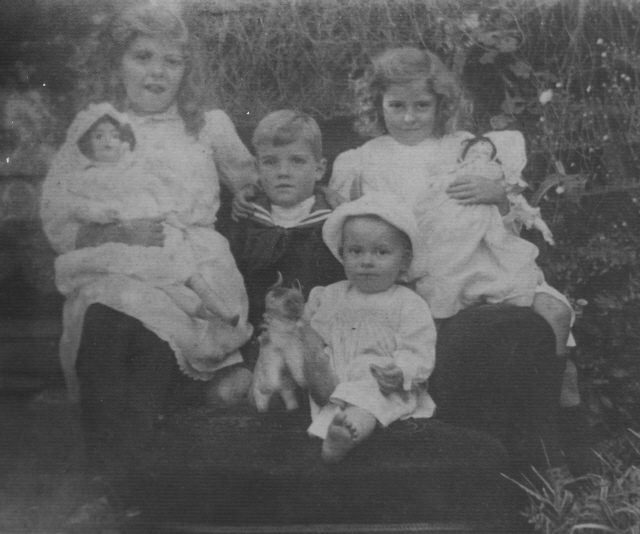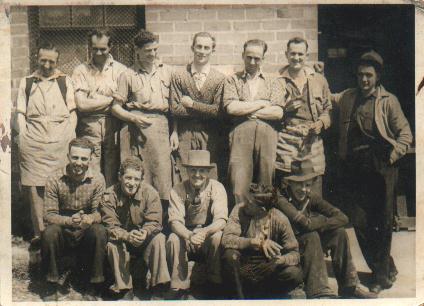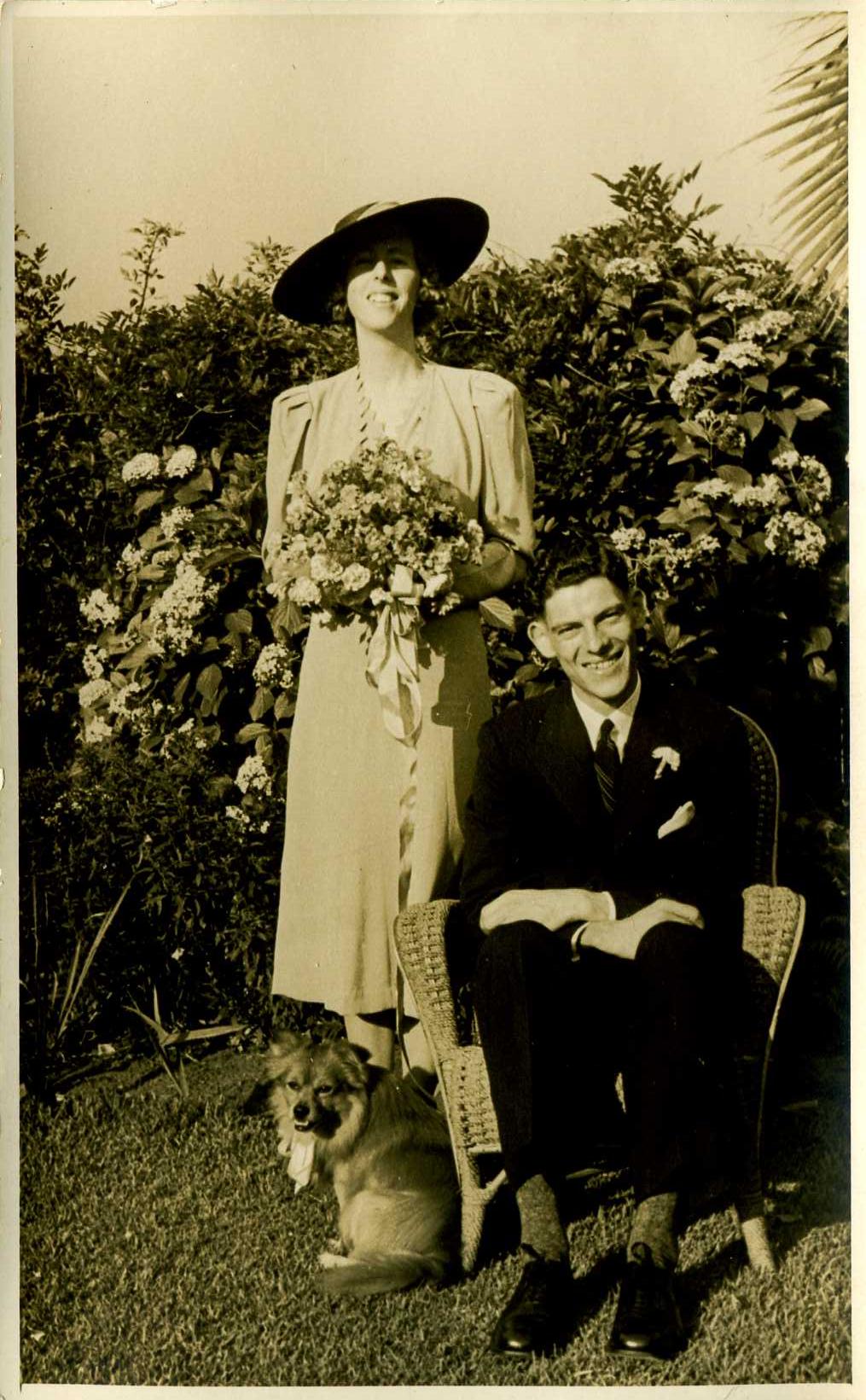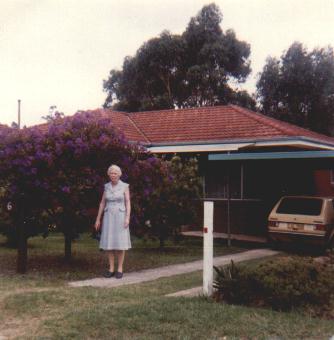
The Life and Times of Jack Callaghan
Early Years - Goulburn
My life started in Goulburn at 17 Mayor Street on Guy Fawkes Day the 5th November 1912. It was also Tuesday Melbourne Cup Day. Piaster won the Melbourne Cup that day.

My parents were Daniel Henry, who we always called Father, and Ethel Jeffrey Callaghan, my Mother who we always called Mum; I was the youngest of four children; my brother and two sisters were, Ethel Nellie (Nell) the eldest, Valerie Alice second eldest and Geoffrey Daniel Wilson Callaghan.
My childhood in Goulburn went very quickly because we were only there for 6 years. I played with the neighbourhood children. My brother Geoffrey went to the Bourke Street School and my two sisters went to Miss Oliver’s Private School for young ladies, Miss Lander was the teacher. My two sisters took me to school long before school age to show off their little brother. The school was about ¼ mile from our house which was easy walking distance, and the school was across from what is now known as Victoria Park. In the winter we went skating on the pond in the park. At that time it was very cold in Goulburn and it still is, except now there is no water.
My father and his brothers, Alfred (Bert) and Walter (Wal) used to go rabbit hunting with 12 gauge shotguns. My uncles enlisted in the Army during World War I and I asked them if they would please bring me back a gun so that I could join them hunting. Uncle Harold, who was a son of my grandfather’s second wife Phoebe Grimble, and really a close family friend had a Belgian wife whose name was Emily Appeline Juliette Riverlarde. My father was teaching her to speak English. One of the old English rhymes he taught her was “I chased a bug around a hill I will have his blood he knows I will.”
I became very ill with Meningitis and was unconscious for about a week. I recovered completely, but after I had Meningitis my sister Nell contracted the same thing and she died. She was 14 and it was 1918. The consequence of Nell dying was that the family were not happy in Goulburn so the Railway whom my Dad worked for transferred us to Sydney.
Move To
Sydney
We moved in 1918 to No. 100 The Boulevarde, Lewisham. My grandmother Sarah Callaghan nee Stidworthy lived in Henry Street, Lewisham which gave us an idea on where we wanted to live, near the family. We moved to 56 Victoria Street, Lewisham after about six months. It was pretty unmemorable there. We were only there for about a year and then my father bought a house at No. 30 Denison Rd Lewisham in 1920. I have many good memories living in Denison Road Lewisham. One time my Father came home from work with his leather lunch case and inside he had a sandwich he had not eaten. So I was allowed to eat it, and thereafter I used to look for a left over sandwich in his bag when he got home. My mother’s sister came to live with us, her name was Annie Robinson Wilson. During her wanderings around the western suburbs she discovered my mother’s great Aunt at Lydham private hospital on the outskirts of Marrickville in Addison Road. Arrangements were then made for great Aunt (Annie Nicholas -Aunt Ann) she was a wealthy old lady who had been living at the Queens Club opposite St. James church Kings Street Sydney. The club was situated where the Supreme Court now stands. Annie left most of her money to the St James Church.
At Aunt Anne’s suggestion in 1922 my brother Geoffrey and I joined the choir of St James Church. I was then 9 years old, almost 10 at that time. We sang at Gladys Moncrieff’s wedding in 1924. I became the soloist for the St. James choir in 1926. We sang three times on Sunday. We caught the train every Sunday from Lewisham to Central and we were given pennies to pay our fare in the tram from Central to King Street. We often walked so that we could spend the pennies on some treats usually lollies.
I can remember walking down Elizabeth Street on our way home along by the doorways of Mark Foys and ladies of the night would say hello to us from the doorways.
Starting Work
I left the choir in 1928. I continued my association with the choir though because the choirmaster George Allman, let it be known amongst the choir boys that Sutton’s Limited the music firm had moved a branch to Sydney and wanted a couple of boys to work for them. One of the choir boys Bob Morrell and I said yes we were interested in working for the firm of Sutton’s Limited and we were told to report to Mr. John Dean who was one of the basses in the choir. John Dean was the manager of the sheet music department of Sutton’s.
We got the job and I started working for the firm. In 1929 the Great Depression started and by September 1931 Sutton’s found they could not remain open in Sydney and went back to Melbourne and I found myself without a job. Fortunately my father never lost a days work as he was still working for the Railways. My brother and I were without work and couldn’t get a job anyway, although I used to work for the grocers every now and then delivering groceries. I was still living at home at that time.
My sister Valerie had been apprenticed to the
milliners at David Jones and she made beautiful hats. She made hats for the
wives of Sir Donald Bradman, the famous cricketer and Sir Charles Kingsford
Smith, the aviator. She eventually left David Jones and worked for Anne Collins
and Henriette Lamotte who were well known Sydney milliners. Val had been on
holidays on an orchard in Conobolas and told me there was a job for me if I
cared to go and work in the orchard with board and keep with some money left
over. The year was 1933 and it was the Christmas cherry, apples, pears and
plums picking season. There would be work until May 1934. After the picking
season was over I came back to Sydney.
A chap who lived opposite us in Denison Road called me one day in 1937 and said that he was working for a cousin of his who owned a joinery shop in Crows Nest owned by Toland Bros. He knew that I was in need of a job and would I like to go and work there, which I did. When I was established in the job I decided that the best thing I could do was to go to night school and enrol in the carpentry and joinery course they were conducting. I joined the course and I went to the night school at Leichardt. The depression was easing quite considerably and I was very fortunate to have a job. Unfortunately the war was about to begin.
Marriage
My mother, who was a high flyer, and I used to go to dances in the Dulwich Hill Masonic Hall. The chap who lived next door to us in Lewisham, Syd Wood asked me one day if I would like to go to a dance at the Hall which I did and it was there I met Jean Blomfield who was to become my wife. She was a looker. It was 1934. We kept company for four years until 1938 and on Christmas Eve Jean and I were married.
Our wedding day was a lovely day with bright blue sky. It was 3pm and we were married at All Saints Church of England, Petersham. Jean wore a hat made by my sister Valerie and she had a beautiful bouquet of delphiniums. She looked lovely. We had the reception at our house at 30 Denison Road, Lewisham. My mum did the cooking for the wedding.
I had a week off work and we caught the train up to Katoomba for our honeymoon. We stayed at a Guest House. The weather was nice although it was very foggy sometimes.
When we got back from our honeymoon we decided to rent a house from a builder who we were doing business for in the joinery place. He was building spec homes in Whiting Street, Artarmon. The rent was 27/6 a week. We moved into the house there for about three months and then Jean who didn’t like Butcher Bros. brickworks putting soot all over her washing wanted to move so we moved to 109 Cremorne Road, Cremorne Point. It was lovely.
We loved it there, however the war started and Toland Bros. who had to pare down their prices to stay competitive had the receivers come in 1940 and so that was the end of that. I got a job at HS Whitehead and Co. Wattle Street Ultimo in the office. They were parcel delivery and general carriers who were the best known in Sydney at the time. Jean got a job at Woolworths at Crows Nest.
While I was employed in the joinery business making doors and sashes for the defence forces I was in a protected industry but when they became liquidated I was no longer protected and in March, St. Patrick’s Day, 1942 I was called up for Military Service. This is the reason that Jean never liked St. Patrick after that. She said she hated him.
Military
Service - World War II
So I found myself in the Army in the 21st Field Regiment and we went by train up to Rutherford which was a camp in the First World War. It had been condemned and was considered unfit for human habitation. It was an extremely dusty place. While I was there I was sent to Signals School at a place called Allandale. I was there for 2 – 3 weeks and when I finished that course I found that the regiment had moved to the showground at Wingham. We were there for six months and then we drove by truck to Taree and then by train to Brisbane. The train was a flatbed one so we could drive the trucks up onto the train. The trucks were driven the length of the train. We detrained at Brisbane and drove out towards Toowoomba and up to Mergon.
I concocted a code to Jean so we could converse. You take the first letter of the first sentence and the second letter of the next sentence and the third letter of the next sentence and so on and it would tell her where I was.
Jean received a letter from me which indicated that the code was in there. Jean asked my father if there was such a place called Mergon and he said yes. It is not too far from Gympie. It rained and rained and rained and the whole regiment became bogged. They hauled the vehicles out of the bog and we went to the showground at Gympie. They grew great watermelons in Mergon. We used to sit in the tents and eat watermelons and throw the seeds out and in a couple of days there were little plants coming up.
In Wingham I joined the A.I.F. (Australian Imperial Forces). I was there for 12 months, in early 1943 they broke up the regiment, put us in troop trains and sent us north. We finished up in a place called Kairi, which is not there anymore because they built a dam and then flooded the town. We were only there for a week or so and then I was drafted to the 2nd/2nd Field Regiment, which had just come back from the Middle East. We went on with artillery training until 1944. Towards the end of 1944 I was put into the 2nd/6th Australian General Hospital (AGH) with some muscular complaint, arthritis, which proved to be very painful. I was there for a couple of weeks and then sent back to my unit.
After a couple of months I came down with the same complaint and I was sent to the 2nd/2nd AGH. I was told subsequently that I had Dengue Fever. After a couple of weeks I went back to the regiment and then one night I was told I was needed at the orderly office. I went along there and they said the regiment is off to New Guinea but you are not going, so get your gear. At 4.00am the next morning a picket woke me and took me to the orderly office and I was ready to go. So I went to the railway station at 4.00am and made a very slow trip to Redbank, which was an army camp near Cairns. I was there for a week and then went to Townsville for a week.
Eventually I went to Brisbane where I was given various vocational tests to determine what I would be suited for. They discovered that I was very suitable to do engineering. Jean said I was an engineering genius. I was so good they sent me back to a signals unit near Atherton, where I marked time until they sent me on leave back to Sydney. I crawled back to Sydney in the train.
At the end of my leave we took the train back to Brisbane and as we detrained and walked along the platform towards the engine it was broadcast very excitedly by the engine driver and conductor that the war was all over. We went back to Atherton and the signal unit where we marked time until they sorted us out and I was one of the first batches to be dispatched back through Brisbane, to Sydney and down to Albury and Bonegilla to await discharge. We listened to the 1945 Melbourne Cup at Bonegilla and shortly afterwards we were sent by train to Sydney.
The War Ends
I was discharged from the Army on 5th December 1945, and when I got home Jean was living with her mother in a house in Lidcombe, 35 Rawson Street. They were both at work and didn’t know where I was, but the lady next door, Mrs. Meredith invited me in to wait until they got home. So great was the excitement when I walked in. After my return, Jean and I had a holiday in Sawtell for about two weeks.
Then I had to go and get a job. H.S. Whitehead by this time were almost out of business and unable to take me back. After about a week I started at F.A. Jackson, furniture manufacturers at Newtown, but it was assembly line work which I did not like at all, and I resigned after a week. After that I applied to the Railways Department, and was given a job in the General Deliveries Section at Darling Harbour goods yard. My first job involved reconciling the ledgers with goods delivered, which I did not enjoy, and so when I heard that a new Investigations Section was being started I applied for a job there. I was transferred to this section early 1947. I asked my boss to look out for a job at Enfield for me, since this was close to where I was still living at Lidcombe, which happened during 1948.
We Build
Our House
In the mean time, during 1946, we had bought a block of land at 176 Virgil Avenue, Chester Hill for about £47. This site included foundations already laid, a large quantity of bricks and a completed garage. We had planned to build a fibro house, but acting on advice from Jean’s uncle, Roly Colefax, who was a builder, we decided to build it in brick, which he did for us. The house was completed in late 1950 because there was a severe shortage of building materials after the war.
Children Arrive
In October 1946 our first child, Bruce was born. At the time we were living in the garage at Chester Hill, but Bruce contracted glandular fever and moved to Lidcombe for a few weeks. Our second child, Helen was born in September 1950, just before we moved into the house.
We lived at Chester Hill until 1956. During our time there the area was still mainly bush and there was no sewer connected. We bought our first car, a 1948 Vauxhall 12, in 1954. We took this car on holidays to Montville in Queensland and down around Bega on the south coast of N.S.W.
Move To Killara
After both Helen and Bruce contracted Hepatitus, we decided to move to a more developed area. We sold the house for £4,000 and bought our next house at 30 Essex Street, Killara for £6,000, set on a large block of land which included a chook yard with about 18 hens.
We sold our Vauxhall in 1958 and bought a Volkswagen beetle which we used to tow a caravan to Rockhampton. We also drove to Melbourne via the coast in 1960 and took the Princess of Tasmania to Devonport, which was the start of a holiday which took us all over Tasmania.
We bought an unserviced block of land at Croll Street Bluey’s Beach in 1962 overlooking the ocean. About 1966 the electricity was connected and shortly after that we cleared the land and Geoff Cooper, a local builder, started building a house for us. It started with a laundry downstairs and later the rest of the house was built on top.
From 1960 to 1973 I worked at Alexandria Goods Station, verifying the goods that were to be distributed to companies throughout Sydney. This job gave me lots of contact with distribution companies who could provide all sorts of goods at wholesale prices, although I did not take advantage of this very often. I retired in January 1973 and was offered the choice of a lump sum or an indexed pension for life. I took the pension which turned out to be a great decision.
Children Get Married
Helen was married to Lance Dempster in 1971 and moved to Hornsby Heights. Bruce moved out in 1972 and was married to Glenda Grice that year.
We bought a Kombi van in 1972 and fitted it out for camping with some very well made wooden fittings which we bought second hand. Jean and I went right around Australia in the van just before the new road across the Nullabor was opened. We travelled via western Queensland, across the Northern Territory and down the down the west coast of Australia. It rained heavily the night before we started our trip on the old road from Perth to Adelaide which was covered with potholes full of water.
We Leave
Killara - Grandchildren Arrive
We sold the house at Killara in March 1973 and moved to our house in Bluey’s Beach. On 3rd July 1975 Glenda had our first grandchild, Leanne and then on 14th August 1976 our second, Amanda. We lived at Bluey’s until December 1979 when we bought a house in Blaxland in the Blue Mountains. At that time Bruce lived in Springwood and we lived there until February 1985. On 17th February 1981 our third grandchild Laura arrived and on 8th December 1982 Helen had her first child, Elise and on 2nd June 1985 her second Margot. I had a problem with gallstones at the end of 1984 and had an operation in February 1985 in Royal North Shore Hospital which fixed that problem.
Overseas Trips
In 1980 Jean and I flew to London and joined a coach tour which took us to Land’s End, then up to Bath, Chester, Wales, Scotland to the Isle of Skye and Inverness, then back down the east coast through Edinburgh and back to London. After that we took the hovercraft from Dover across to Calais and joined a coach tour which took us up through Belgium to Holland, then to Germany, Austria, Yugoslavia, Macedonia and Greece. From Athens we flew to Singapore where we stayed overnight. When we went down to breakfast the next morning we were surprised to see Helen and Lance waiting for us and we spent a week together in Singapore, and then flew back to Australia.
The following year we returned to the UK and hired a car in Aberdeen and toured around Inverness and Ullapool staying at Mrs McKenzie’s Bed and Breakfast, then on to the Isle of Skye and back to the mainland at Mallaigh. After that we drove along the northern bank of Loch Ness, then south to Edinburgh and back into England to Stanhope where we stayed overnight. The next day we drove to Middlesborough where we dropped off the car and caught the train back to London.
From London we flew to Oslo and took a tour of Norway and Sweden ending up at Bergen where we saw Edvard Grieg’s piano, and then flew back to London.
From London we flew to Dublin and took a tour around Ireland ending back in Dublin, then back to London and home to Australia.
Move To Turramurra
In 1985 we were about to pack up and move from Blaxland when I found myself in hospital. By the time I left hospital we had moved to temporary accommodation in Helen’s place, which was now at Exeter Road Wahroongah. Jean had already found what she thought was a suitable unit in Turramurra Court and when I saw it I thought is was perfect, so we bought the unit, moving in March 1985.
Jean Dies
We lived together in the Turramurra unit until Jean died on 20th June 1990. I continued to live there on my own from then on. I have done quite a bit of touring in the car since that time around New South Wales and Southern Queensland, often to visit relatives; the Murrays at Warren and my niece Susan at Mt Tamborine.
I also started taking bus trips with the United Protestants Association to places like Port Stevens, the Blue Mountains, Merimbula and Mollymook. One day I decided I would like to see the town of Bright in Victoria, so I drove down there via the Snowy Mountains.
Trip To France
In September 2003 I flew to France to attend the wedding of my grand-daughter Laura to Guillaume de Matrin-Donos. I flew over with Bruce and Leanne via Kuala Lumpur, Vienna, Munich then to Toulouse where Bruce hired a van and Guillaume drove us to his home village of Lasserre de Prouille. In the week before the wedding we drove down the coast of Spain to Barcelona. We also did some touring around the villages and towns of Haute Garonne and Aude before flying out of Toulouse to Vienna via Munich. We stayed overnight in Vienna.
I continued making car trips, mainly to Mt Tamborine, until I finally stopped driving in November 2006 and sold my Toyota Corolla. I also took some trips to Moruya with Bruce to look for information on some of Jean’s ancestors.
Jack Playing Piano (at age 92) - Click on play arrow on picture below